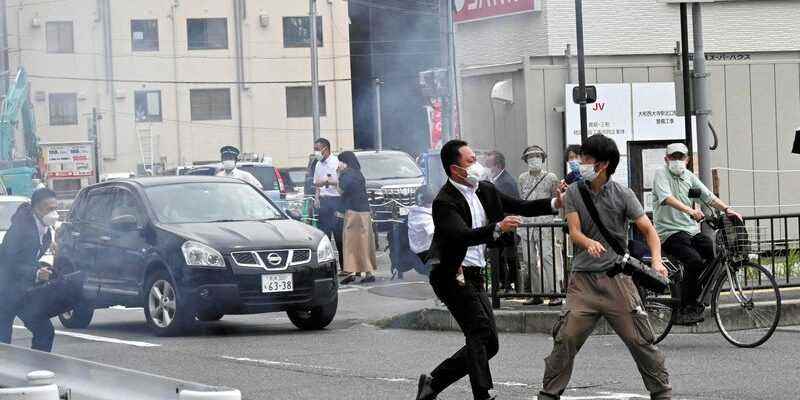The inability to shield Abe from the second shot followed what appears to be a series of security failures in the run-up to the assassination of Japan’s longest-serving prime minister on July 8, Japanese and international experts said.
The killing of Abe in the western city of Nara by a man using a homemade weapon shocked a nation where gun violence is rare and politicians campaign in close proximity to the public with a light security.
Japanese authorities – including Prime Minister Fumio Kishida – have acknowledged security shortcomings, and police say they are investigating.
In addition to security experts, Reuters spoke to six witnesses at the scene and reviewed several videos available online, taken from different angles, to piece together a detailed account of security arrangements before the shooting.
After leaving Abe, 67, exposed from behind as he spoke on a traffic lot on a public road, his security team allowed the shooter – identified by police as Tetsuya Yamagami, 41 – to escape. approach a few meters from Abe unchecked, while carrying a weapon, the footage showed.
“They should have seen the attacker go very deliberately to the back of the prime minister and intervene,” said Kenneth Bombace, director of Global Threat Solutions, which provided security for Joe Biden when he was running for president.
Yamagami approached about 7 meters (23ft) from Abe before firing his first shot, which missed, the Yomiuri newspaper said, citing investigative sources. He fired the second shot, which hit, about 5 meters, according to the newspaper.
Abe’s bodyguards didn’t appear to have “concentric rings of security” around him, said John Soltys, a former Navy SEAL and CIA officer, now vice president of security firm Prosegur. . “They didn’t have any sort of surveillance in the crowd.”
Asked about the experts’ analysis, the Nara Prefectural Police, in charge of security for Abe’s campaign stage, told Reuters in a statement that the department was “committed to thoroughly identifying security issues”. read Abe’s protection, declining to comment further.
The video shows that after the first shot, Abe turns and looks over his left shoulder. Two bodyguards rush to get between him and the shooter, one of them lifting a thin black bag. Two more move towards the shooter, who approaches through the smoke.
Although Abe’s security tackled the assailant moments later and arrested him, it was the “wrong response” for some security to pursue the shooter instead of acting to protect Abe, said Mitsuru Fukuda, a professor at Nihon University who specializes in crisis management and terrorism.
There was enough security, “but no sense of danger,” said Yasuhiro Sasaki, a retired police officer from Saitama prefecture, near Tokyo, who handled VIP security. “Everyone was surprised and no one went to where Abe was.”
The Tokyo police, in charge of the bodyguards of political figures, referred the questions to the Nara police.
The National Police Agency, which oversees local police forces, said Abe’s murder was the result of the police failing to fulfill their responsibilities and said it had set up a team to review security and protection measures and to consider concrete measures to prevent such a serious incident from happening again.
“We recognize that there have been issues not only in the on-site response, such as setting up security and protection, deployment of staff and basic security procedures, but also in the way the “National Police Agency was involved,” she said in response to questions from Reuters.
Reuters could not reach Yamagami, who remains in custody, for comment and could not determine if he has a lawyer.
THIS COULD HAVE BEEN QUICKLY
The footage shows four bodyguards inside the railings as Abe spoke, according to Koichi Ito, a former sergeant with the Tokyo Metropolitan Police’s special assault team, now a security consultant. Their number was corroborated by local politician Masahiro Okuni, who was on the scene.
When the former prime minister stepped forward to speak, Yamagami could be seen in the video footage in the background, applauding.
As Yamagami advanced behind Abe, security did not appear to intervene, according to the footage.
Abe should have had a bodyguard dedicated to close protection to keep him away, said a member of the US diplomatic security service, which protects high-ranking diplomats and foreign dignitaries.
“We would have grabbed him by the belt and the collar, we would have protected him with our body and we would have walked away,” the agent said.
Katsuhiko Ikeda, a former Tokyo police superintendent general who led security at Group of Eight summits in 2000 and 2008, said things would have turned out very differently if Abe’s security department had been close enough to reach it in a second or two.
Ito, the former police sergeant, said security could have stopped the first shot if they had been vigilant and communicated.
“Even though they missed it, there was a window of more than two seconds before the second shot, so they definitely could have prevented it,” he said. “If Abe had been protected properly, this could have been avoided.”
